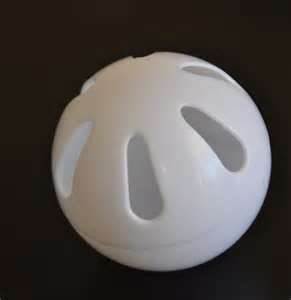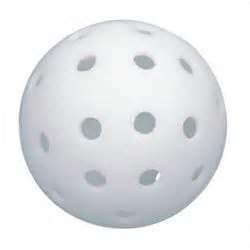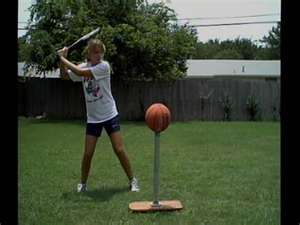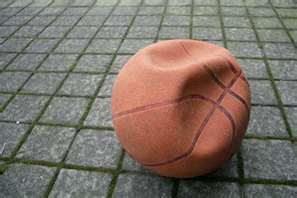Baseball Hitting Drills
There are numerous versions of different Baseball hitting drills each designed to address a specific concept or issue related to hitting. I’m going to teach you three (3) drills which address different skills and needs.

Slotted Whiffle Ball -
Learning Solid Contact:
There is no better method of learning the basic mechanics of becoming a good hitter than by Hitting Off a Tee. This drill is designed to teach the hitter to consistently hit the ball properly, which is mechanics specific, intended to program hitting muscles and eye to ball coordination.
In layman’s terms, hit the ball square and hard, and the beauty of this drill is you’ll instantly know if you accomplished your goal.
Required Equipment:
(1.) For this drill you’ll need a bucket of whiffle balls, you can use one ball if you want to chase it each time, but that defeats the purpose of the drill…. Which is lots and lots of swings.
(a.) Buy good Quality baseball size whiffle balls, not a softball size. The drill is intended develop eye to bat to ball coordination through hundreds of swings, and over a short period of time cheap equipment will break down, not being able to hold up to the abuse.

Holes Only Whiffle Ball -Baseball Hitting Drills
(2.) Buy either a quality baseball size whiffle ball bat, a cork ball bat, or you can saw off a solid broom handle to use. Any of the three is fine to use, but I prefer the cork ball or broom handle over the whiffle ball bat.
(3.) A batting tee.
Execution:
Set the tee at a specific height, and specific position on home plate, which you’ll change daily or each session, in order to simulate pitches located in different areas in the strike zone.
If practicing by yourself and in order to reduce wasted time retrieving the batted balls, I’d suggest hitting into a net or against the side of the garage or at least a fenced in area. However, it is imperative you maintain adequate room for the ball to react, so if you’re hitting against a solid backstop position the tee at least 30 - 35 feet away from it in order to view the results and limit damage to the whiffle balls.

Everyday Broom Handle -Baseball Hitting Drills
I mentioned ball reaction and that’s because the key to knowing if you are performing your swing correctly, thus doing the drill correctly, is the reaction of the ball as it comes off the tee.
When you hit the ball off the tee solidly, the ball will travel in such a manner as you’ll be able to hear the air flow through the holes, which will produce a whooshing sound. Depending on the ball’s size of holes or slots, the whooshing sound may be loud or it may not.
If you don’t hit the ball correctly, solidly, as the ball comes off the tee it will slice, dip, soar, or spin when it hits the ground. This reaction indicates you most likely struck the ball on the lower or upper portion of the ball creating a back spin or slice.

"Partially Deflated Ball on Plunger Stand" - Baseball Hitting Drills
Adjust your swing mechanics until you consistently hit the ball hearing the whooshing sound as the air flows through the ball. Practice, practice, practice. Repetition, repetition, repetition. It’s the only way to improve and inch forward to your ultimate goal ….perfection.
Increasing Power: - Baseball Hitting Drills
There are numerous factors which affect and can be addressed in order to increase power and this is one method. Martial arts student, boxers or any other athlete who wants to increase their power, whether it be a punch, kick or bat swing, are taught to power Through your target.
This drill is designed to increase your hitting power by teaching you how to power through your target by hitting a heavy object and learning to swing through it eliminating any pause or hesitation, which reduces power.
Required Equipment:
Clickbank Products
(1.) You’ll need a partially deflated soccer ball or basketball;
(2.) A quality hitting tee;
(3.) A large cupped plumbers plunger;
(4.) Bat, wooden or composite.
Purpose/ Intent of the Drill: - Baseball Hitting Drills
The intended goal is to learn how to be able to hit the deflated ball off the tee without incurring any hesitation in your swing as the bat makes contact with the ball. This ability increases bat speed and enhances follow through which vastly increases power.

Too Deflated - Baseball Hitting Drills
Execution:
Begin by sliding the plumbers plunger, handle first, into the hitting tee with the plunger end up, which will be used to cradle the basket ball / soccer ball. This extra weight and required balance is why a quality batting tee is required.
Using your natural batting stance, swing and drive the deflated ball off the tee. Don’t try to squeeze the bat handle too tightly, but be sure to have a firm grip or else you could injure your wrist from the bat’s sudden impact with the deflated ball. Once you perform this drill several times you’ll become accustomed to the impact reaction, thus reducing any risk of injury.
Initially you will experience a pausing of your bat, maybe even a complete stopping, as you strike the ball, but as your swing becomes more powerful and your bat speed increases you will eliminate this pause or hesitation of the bat upon contact.
Besides being able to see results, positive or negative, rather quickly you can also use these visible results to see whether adjusting hip rotation or your strength training program is improving your power swing.
Conquering the “Back Out” Problem:- Baseball Hitting Drills
As a coach, every now and then you’ll run across a youngster who is terrified of the baseball and no matter how much persuasion or coaxing you do, he will automatically begin backing out of the batters’ box as the pitcher begins his wind up, despite not having a clue as to where the ball is going.

Raquetball works as well as a tennis ball -Baseball Hitting Drills
This drill may at first appear barbaric, although it’s completely safe, and if the child can not overcome their fear of the ball their baseball career is over before it begins. As the coach always inform the parent how the drill will be performed and it is a safe drill intended to help the player conquer their fears. You don’t need an irate parent calling screaming about their kid telling them you were intentionally hitting them with baseballs.
Required Equipment:
(1.) A dozen tennis balls, which you may as well purchase anyway because you’ll use tennis balls for other skill drills.
Execution/Intent:
The intent of this drill is for the coach to intentionally throw the tennis ball slightly behind the hitter, trying to hit him with every throw as he backs out of the box.
If the batter is truly afraid of the ball, he will automatically back out of the batter’s box even though you have told him what you’re going to do. Do not rush this drill, but rather perform it in a methodical method, where the player will continue getting hit by the tennis ball until it finally registers:
(1.) Getting hit with a ball doesn’t hurt like he feared it would;
(a.) You have made a point of telling him you’re throwing it hard enough to be comparable to being hit with a baseball, a slight exaggeration;
(2.) He needs to watch the ball to see where it is going, because backing out of the batters box obviously doesn’t insure he won’t get hit.
This drill may have to be performed numerous times before the player totally conquers his fear and stops backing out of the box, but patience and perseverance on the part of the coach will be successful. I have used it and several coaches I taught have used it, all successfully.
Baseball Hitting Drills to Teaching Hitting
GO TO Teaching Hitting FOR COMPLETE IN-DEPTH INSTRUCTION AND TIPS:

New! Comments
Have your say about what you just read! Leave me a comment in the box below.